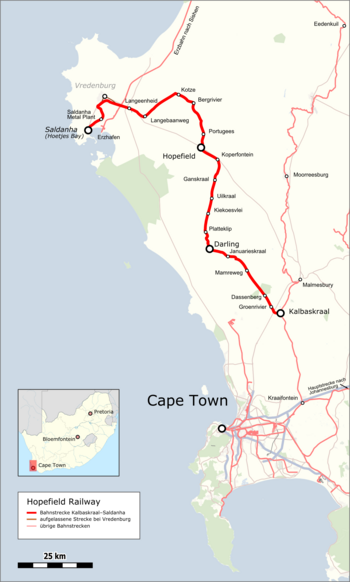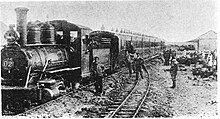Hopefield Railway
| Hopefield Railway | |||||||||||||||||||||||||||||||||||||||||||||||||||||||||||||||||||||||||||||||||||||||||||||||||||||||||||||
|---|---|---|---|---|---|---|---|---|---|---|---|---|---|---|---|---|---|---|---|---|---|---|---|---|---|---|---|---|---|---|---|---|---|---|---|---|---|---|---|---|---|---|---|---|---|---|---|---|---|---|---|---|---|---|---|---|---|---|---|---|---|---|---|---|---|---|---|---|---|---|---|---|---|---|---|---|---|---|---|---|---|---|---|---|---|---|---|---|---|---|---|---|---|---|---|---|---|---|---|---|---|---|---|---|---|---|---|---|---|
|
State of the Cape Gauge route in 2016
| |||||||||||||||||||||||||||||||||||||||||||||||||||||||||||||||||||||||||||||||||||||||||||||||||||||||||||||
| Route length: | Kalbaskraal – Hopefield: 76 km. Hopefield – Saldanha: 67 km |
||||||||||||||||||||||||||||||||||||||||||||||||||||||||||||||||||||||||||||||||||||||||||||||||||||||||||||
| Gauge : | up to 1926: 610 mm from 1926: 1067 mm |
||||||||||||||||||||||||||||||||||||||||||||||||||||||||||||||||||||||||||||||||||||||||||||||||||||||||||||
|
|||||||||||||||||||||||||||||||||||||||||||||||||||||||||||||||||||||||||||||||||||||||||||||||||||||||||||||
The Hopefield Railway , also Kalabas Kraal – Hopefield Railway , today Railway Kal (a) baskraal – Hopefield – Saldanha , is a South African railway line north of Cape Town . It was opened in February 1903 by Cape Government Railways (CGR) as a narrow-gauge line with 610 mm gauge. In 1926 the gauges were changed to the Cape gauge and the railroad has operated like this ever since. Today the railroad is only used for freight transport. The end of the line in Saldanha is part of the westernmost section of the rail network in South Africa .
history
Towards the end of the 19th century, farmers in the Hopefield region asked for their own railway line to bring their produce to Cape Town. The Hopefield Railway Committee managed to lobby the Cape Colony government of the plan, so that in 1900 they approved the construction of a narrow-gauge railway for £ 135,000 . The earthworks already took into account a possible change of gauge to Cape gauge.
In the same year surveying work was carried out and it was decided that the railway should branch off from the Cape-gauge railway line to Eendekuil at Kalbaskraal (other spelling is also common) . Because of the different gauges, a handling facility had to be built in Kalbaskraal. To make reloading easier, the tracks of the narrow-gauge railway were raised so that the floors of the wagons were at the same height despite the different track widths. The 76 km long route of the narrow-gauge railway was not led directly to Hopefield, but via Darling , in order to open up as much agricultural land as possible. Construction began in 1901, reaching Darling on October 4, 1902, and Hopefield on February 28, 1903.
In May 1904 a report of the government committee responsible for the railway was published, which recorded some grievances. In addition to poor management, the high freight charges were criticized. Next it seemed to gondola cars and boxcars to be lacking. There were no goods sheds or a roof over the transshipment facility in Kalbaskraal. The stations were not fenced in, so cows ate the vegetables that were ready for transport. Furthermore, the passenger train service should be improved and accelerated in order to catch the early train to Cape Town in Kalbaskraal.
Although the railway was not able to show a profit every year, it basically fulfilled the transport tasks for agriculture, so that it was extended via Vredenburg to Hoetjies Bay (today Saldanha) and crossing stations were built in until February 1913 .
The line was converted to Cape Gauge; the first train ran on December 19, 1926 the line in the new gauge.
vehicles
Traction vehicles

Three steam locomotives with a 1'C wheel arrangement were purchased from Baldwin in the USA for the construction of the railway . They received the numbers 1 to 3, were later referred to as CGR No. NG 1 to 3 , the abbreviation NG for Narrow Gauge (German: "Schmalspur"). These locomotives handled all rail traffic until an eight-seat petrol multiple unit was purchased in 1907 .
With the extension of the Hopefield Railway to Hoetjies Bay, a fourth locomotive of the same design as No. 1 to 3 was procured, which began operation in 1913. Likewise, the NG 25 locomotive of the CGR type A and a locomotive of the CGR type B made it to the Hopefield Railway. Both locomotives originally ran on the Avontuur Railway . At times an NG 9 locomotive was also in use.
In 1915 all of the locomotives supplied by Baldwin except No. 3 were handed over to South West Africa , where they were urgently needed in order to combat the locomotive shortage in South West Africa after the First World War .
dare
When it opened, the company had two 1st class cars with four compartments, two 3rd class cars with five compartments and five half-luggage cars with twelve 1st class seats. The latter also served as a place to stay for the train crew and were used as freight train escort cars.
20 low side cars , 4 flat cars , 32 cattle cars , 3 pairs of turntable wagons for timber transport and a manually operated 6-tonne rail crane were available for freight transport. Some of the freight wagons were probably delivered as flat wagons and only converted afterwards.
After the track was re-gauged, the Hopefield Railway's vehicles were used on other 610 mm gauge railways of the South African Union .
business
When it opened, only the Kalbaskraal, Darling and Hopefield stations were occupied. The locomotive depot was in Kalbaskraal.
Passenger trains ran from Kalbaskraal on Monday, Wednesday and Friday and returned on Tuesday, Thursday and Saturday. Because this offer was too meager for the local landowners, a railcar was procured that ran on days without a steam train. From 1907 he carried out extra trips to visit the theater in Cape Town under the name Theater Special .
Web links
Individual evidence
- ^ A b c Roaming the Western Cape Rails. In: The Heritage Portal. Retrieved March 5, 2016 .
- ^ A b Legislative Council of the Cape Colony Governement (ed.): Report of the Select Committee on Kalabas Kraal-Hopefield-Railway . Cape Town May 1904 ( html ).
- ↑ a b c d e f g h The Hopefield Railway. In: On the right track. Retrieved March 5, 2016 .

